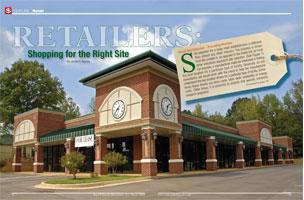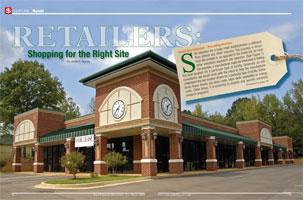
 Retail Site Selection – Prevailing Practice
Retail Site Selection – Prevailing Practice
Site selection for a large retail establishment is different than almost any other industry. The process is driven from the outside in, as opposed to the inside out, as most other industries approach site selection. For example, a manufacturer might be interested in finding the best location for a particular type of facility. Generally, as site consultants, we would work with the client to help the manufacturer understand the key location drivers for a particular type of facility. Sometimes these drivers are labor costs, labor skills availability or energy costs. Other times, it is proximity to airports and specific university research programs. In the distribution industry, site selection decisions are driven primarily by logistics costs and time-to-market considerations. In the office sector, work force skills, cost and availability can often be paramount. Even the hospitality sector approaches site selection from a remarkably different perspective.
Retail industry location choices, specifically for store locations, are more often than not driven by the availability of a suitable development project (see Figure 2). Normally, retailers will do market studies of broad market trends, such as population growth, housing construction trends, and per capita expenditure patterns to identify market areas in which they may desire expansion opportunities. But from this point, the site selection process diverges significantly from other types of industry location projects.
Specialty retailers, also referred to as “Big Box” retailers, often look to the development community to identify locations within a particular marketplace which may have the best potential for retail expansion.
Often, major national retailers will maintain regional real estate managers whose job is to get to know the development community in the markets in which they are interested in expanding, in order to get early notification of potential new retail development projects. In other words, the retail development process is primarily a real estate driven process wherein the initiative to provide a suitable location is the retail development industry’s responsibility. This is why trade shows such as ICSC are so critically important in the retail industry and why retailers generally look to the development community to be the catalyst for deal-making.
Once a potentially suitable site or building has been brought to the attention of the real estate manager of an expanding retailer, there will be some preliminary analysis based on the real estate manager’s own experience of site potential. If, in the opinion of the real estate manager, this site has potential as a retail location, the site will be discussed with the real estate manager’s superiors to determine if the company would have further interest in the site. Since the process is real estate driven, time is often of the essence in determining if the site is potentially suitable because the developer will often introduce the site or building to other competing retailers at the same time. At this point in the negotiations, the retailer is in a race with other retailers to secure an interest in the property before it is gone. The project will often go to internal teams of architectural and engineering personnel, or to outside consultants, to evaluate the building cost and obstacles to development prior to making a commitment to the site.
In addition, internal or external specialists will be called in to derive an estimate of the potential store sales cycle at various points in the future, should the development go forward. Often, retailers will conduct internal evaluations or hire outside consultants to help identify what incentives, if any, could be available prior to making a location decision. Our sister firm, Location Management Services, has conducted thousands of these incentives evaluations – projects wherein estimates of dollar-cost benefits are determined to offset either development costs or on-going operating costs. Such incentives include sales tax sharing arrangements, infrastructure grants for off-site improvements, tax credits for investment and/or job creation, and a number of other creative solutions offered by state and local officials.
Once the company has done its homework on a potential retail site, the three main elements of the analysis – development cost, market potential, and state/local incentives – are forwarded to financial analysts for evaluation and review. The financial analysts generally prepare an ROI (Return on Investment) analysis for each site under serious consideration. Development costs are weighed against the potential revenue from increased sales and financial incentives which can lower start-up or on-going operations. This analysis is often prepared for the Chief Financial Officer, or his/her designee, in order to determine the likely payoff associated with the development of a specific store location. The meeting between the CFO and the head of real estate to discuss potential projects is a significant step in the determination of whether or not a specific site is likely to be chosen by the retailer for development.
If the ROI is sufficient to pass the CFO’s hurdle rate (often between 10 and 15 percent), the project is given the “green light” to go to a deeper level of analysis. Because the CFO of large national chains sometimes reviews from 10 to 20 potential store locations monthly, if you are selecting only three to five new store locations to go forward with, it is critical that all of the information be as accurate as possible for the decision-making process. Some communities will “hold back” critical information, such as potential fee abatements or infrastructure assistance, thinking they are positioning themselves for negotiations. This stance will often hurt the communities when the site is on the borderline of being approved. Some CFOs will ask the real estate manager to go back and see if costs can be reduced or if community incentives can be improved. Others will simply shelve the project for a later time, or drop it from further consideration entirely.
Theoretical Constructs
There is a school of thought in retail site selection that believes that the site selection process can become more scientific and strategic as opposed to the traditional way that site selection has been approached in the past. The idea is to take a more geospatial approach to retail site selection by using sophisticated geographic information systems to pinpoint locations which offer the highest market potential by identifying underserved retail segments. These programs utilize government and proprietary data about consumers living within a given market area and their spending habits. Once the number of potential consumers and growth in that market can be linked with spending propensities and existing retail opportunities, it is theoretically possible to pinpoint the optimal site location for a new retail facility. Figure 3 shows an example of such a computer-based approach.
The problem with this approach is that the retailer has no idea as to whether or not a site exists at that optimal location, how much the development of that site would cost, and whether or not there are state or local incentives which could either lower the development cost or improve operating conditions. If there is no site available, or the site cannot be reasonably developed, there is no benefit in doing extensive work to develop a market potential estimate.
In addition, community leaders may not be interested in retail development and may target available sites for some other land use. The ability of the typical retailer to go through an entitlement process in order to change land use designations is limited. The general reaction to obstacles of this nature would be to simply look elsewhere for a site that can be more easily developed. If the market analysis indicates a large amount of unsatisfied retail sales potential, retailers will simply look for a nearby site to capture this market potential rather than fight a protracted battle with the host community and/or neighborhood groups.
Unfortunately, retail site selection not only incorporates market potential considerations, but also political and real estate considerations as well. This makes retail site selection rather messy and not always a perfect candidate for desktop analysis.
Retail Incentives
There is a great deal of debate as to whether or not communities should provide incentives to retailers, much of it directed toward big box retailers such as Wal-Mart. The general consensus among retailers is that incentives can help make a location work, when it would not ordinarily be developed by reducing development cost and on-going operating costs. Incentives can never replace pure market potential and most retailers would not locate in a community that didn’t have the basic market potential to support a new store location, unless that community is growing fast and will provide market potential in the near future.
That said, incentives can often make the difference between having a new store location built in your community or not. This is due to the fact that most retailers look at three or four potential store locations before choosing one to develop or lease. The potential store locations that do not get built may have some combination of market potential and/or development cost, but not to the extent that it satisfies corporate minimum ROI rates for development. If this is the case, incentives can often be used to increase the ROI of a specific project in order to satisfy corporate minimum requirements. Even then such projects might not get built if there are other alternative store sites that can support a higher ROI projection. Thus retail incentives can help get new retail locations built that may not get built otherwise. It is a political decision which is up to the community as to whether or not such incentives are made available to the retailer or the developer.
Incentives Management
Research has shown that there are approximately $50 billion in tax credits and incentives available for expanding companies in the United States. Less than 1/3 of these incentives and credits are ever applied for and less than ½ of these savings are ever collected. The most predominate retail incentives are performance based – meaning that the beneficiary of the incentive must prove that the jobs, investment and taxes as originally projected are actually produced. This requires a disciplined approach to incentives compliance. Unfortunately, only a small percentage of retailers have processes in place to perform this compliance on a regular basis. The majority of retailers manage incentives on an ad hoc basis, sometimes leaving it up to the local store manager to perform the compliance duties, and at other times dividing the compliance duties amongst tax, finance, human resources and real estate. This leads to a loss of incentives dollars due to non-compliance and falsifies the original ROI assumptions on which the project was approved.
In our work for large-scale retailers, we rigorously manage the incentives compliance process because that is where the real benefits are generated. Some have relied on third parties or legal advisors to negotiate incentive packages, but these do no good unless a compliance strategy is determined early on in the process.
Making the Right Location Decision
Retail site selection decisions are among the most important decisions that a retailer will ever make. A lot can be made or lost on the selection of the location for retail store development. This is why most major retailers prefer to have “boots on the ground” when selecting potential new locations for stores as there are many factors that need to be weighed against one another before finalizing an expansion decision.
Computerized models can be helpful in identifying potential sales opportunities in the landscape, but they will never be a substitute for local knowledge of the marketplace and real estate development conditions. These can only be provided by the retail developer, who plays a critical role in the deployment of retail expansion strategies.
Finally, community incentives have a role in the process, but it is up to the community leaders to understand that role and factor the costs versus benefits of retail development into their thinking about how the community should be developed. Retailers are happy to play a role in this process, but they rely on many others to help them make the right decision.

